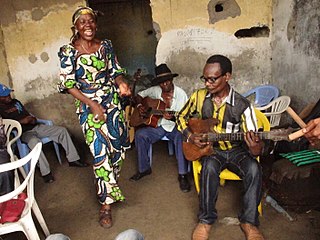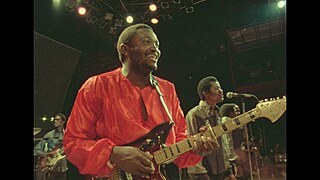
Congolese music is one of the most influential music forms of the African continent. Since the 1930s, Congolese musicians have had a huge impact on the African musical scene and elsewhere. Many contemporary genres of music, such as Kenyan Benga and Colombian Champeta, have been heavily influenced by Congolese music. In 2021, Congolese rumba joined other living traditions such as Jamaican reggae music and Cuban rumba on UNESCO's "intangible cultural heritage of humanity" list.

The music of the Cameroon includes diverse traditional and modern musical genres. The best-known contemporary genre is makossa, a popular style that has gained fans across Africa, and its related dance craze bikutsi.

Music of the Central African Republic includes many different forms. Western rock and pop music, as well as Afrobeat, soukous and other genres have become popular nationwide. The sanza is a popular instrument.

The music of Angola has been shaped both by wider musical trends and by the political history of the country. while Angolan music has also influenced the music of the other Lusophone countries and Latin American countries. In turn, the music of Angola was instrumental in creating and reinforcing "angolanidade", the Angolan national identity. The capital and largest city of Angola — Luanda — is home to a diverse group of styles including kazukuta, semba, kizomba and kuduro. Just off the coast of Luanda is Ilha do Cabo, home to an accordion and harmonica-based style of music called rebita.

Equatorial Guinea's culture has been less documented than most African countries, and commercial recordings remain scarce.
The term Congolese music can refer to the music of two countries:

Soukous is a genre of dance music originating from the Democratic Republic of the Congo and the Republic of the Congo. It derived from Congolese rumba in the 1960s, with faster dance rhythms and bright, intricate guitar improvisation, and gained popularity in the 1980s in France. Although often used by journalists as a synonym for Congolese rumba, both the music and dance associated with soukous differ from more traditional rumba, especially in its higher tempo, song structures and longer dance sequences.

Chad is an ethnically diverse Central African country. Each of its regions has its own unique varieties of music and dance. The Fulani people, for example, use single-reeded flutes, while the ancient griot tradition uses five-string kinde and various kinds of horns, and the Tibesti region uses lutes and fiddles. Musical ensembles playing horns and trumpets such as the long royal trumpets known as "waza" or "kakaki" are used in coronations and other upper-class ceremonies throughout both Chad and Sudan.

Jules Shungu Wembadio Pene Kikumba, known professionally as Papa Wemba, was a Congolese singer and musician who played Congolese rumba, soukous, and ndombolo. Dubbed the "King of Rumba Rock", he was one of the most popular musicians of his time in Africa and played an important role in world music. He was also a fashion icon who popularized the Sape look and style through his musical group Viva la Musica, with whom he performed on stages throughout the world.

African popular music, like African traditional music, is vast and varied. Most contemporary genres of African popular music build on cross-pollination with Western popular music. Many genres of popular music like blues, jazz, salsa, zouk, and rumba derive to varying degrees on musical traditions from Africa, taken to the Americas by enslaved Africans. These rhythms and sounds have subsequently been adapted by newer genres like rock, and rhythm and blues. Likewise, African popular music has adopted elements, particularly the musical instruments and recording studio techniques of the Western music industry. The term does not refer to a specific style or sound but is used as a general term for African popular music.

Zaïko Langa Langa is a Congolese rumba band formed in Kinshasa, in December 1969. Established by D.V. Moanda, Henri Mongombe, Marcellin Delo and André Bita, the band evolved from the Orchestre Bel Guide National, which is seen as Zaïko's predecessor.

Ndombolo, also known as dombolo, is a genre of dance music originating in the Democratic Republic of the Congo. Derived from soukous in the 1990s, with fast-paced hip-swaying dance rhythms, often accompanied by upbeat, percussion-driven music, the style became widespread in the mid-1990s and the subsequent decade, dominating dancefloors in central, eastern, and western Africa. It inspired West African popular music, coupé-décalé, Kuduro, and East African dance music.

Congolese rumba, also known as African rumba, is a dance music genre originating from the Republic of the Congo and Democratic Republic of the Congo. With its rhythms, melodies, and lyrics, Congolese rumba has gained global recognition and remains an integral part of African music heritage. In December 2021, it was added to the UNESCO list of intangible cultural heritage.
Bisso Na Bisso is a music collective originating from the Republic of the Congo. The group was formed in 1999 and consists of rappers and singers, including Ben-J, a member of Les Neg'Marrons; the duo Lino and Calbo from Ärsenik; Doc and G Kill, renowned members of 2Bal; Mystik; and the only female rapper, M'Passi. The group was put together by the French rapper Passi.
Saturnin Pandi (1932–1996) was a soukous recording artist, conga player, in the Republic of the Congo (Congo-Brazzaville) and in the Democratic Republic of the Congo (DRC). He was one of the founding members of the soukous band TPOK Jazz, formed in 1956, led by François Luambo Makiadi, which dominated the Congolese music scene from the 1950s through the 1980s. He was also a member of the Bantous de la Capitale, formed, in Brazzaville in 1959, led by Jean Serge Essous.

Richard Yende Abongy Balengola, best known as Richacha "Chacha" Balengola, is a reggae, Hip Hop, RnB, soukous and world music drummer from the Democratic Republic of the Congo, based in Reims, [[Fr
Aurlus Mabélé was a Congolese singer and composer. He was commonly referred to as the "King of Soukous".
Franklin Boukaka was a Congolese baritone singer, guitarist, and songwriter who is recognized as a pioneer of Congolese popular music. He performed in bands based in each of "the two Congos," i.e., the countries now named the Republic of the Congo and the Democratic Republic of the Congo; toured worldwide; achieved broad popularity; took outspoken political stances; and is widely believed to have been the victim of an extrajudicial execution during an attempted coup in the Republic of the Congo.

Sebene, also known as seben, is an instrumental section commonly played in Congolese rumba. It is usually played towards the end of the song and is the dancing section where the lead and rhythm guitars take the lead in the dance. It is characterized by the repetition of a specific number of notes during the passage of second chords: one major chord and one-seventh chord, which gives rise to the Lingala derivation "sebene," derived from the English numeral "seven" or its ordinal rendition.














